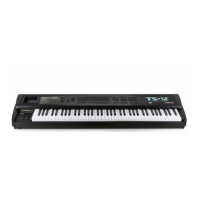Section 7 — Effect Parameters TS-12 Musician’s Manual
26
DETUNE - RATE Range: 00 to 99
Controls the LFO rate of detuning incorporated within the reverb. Detuning creates a slight pitch
shift into the reverberated signal, giving it a more natural sounding decay by breaking up
resonant nodes.
DEPTH Range: 00 to 99
Controls the depth of the detuning, that is, how much the pitch will change. Low values yield a
metallic sound. Some voices sound best with very low values.
54 PHASER + DELAY
PHASER + DELAY combines a phaser with a digital delay. The phaser creates non-harmonically
spaced moving notches in the signal spectrum, whereas a flanger creates harmonic spacing. This
phaser implements a stereo twelve pole phasing network to achieve time delay which is a
function of-frequency; this is what differentiates the phaser from the flanger. The phasing effect
is achieved within the phaser topology, so it does not depend upon the external mix. A delay is
included at the left output of the phaser that feeds back into the phaser (see the diagram). Setting
the phaser REGEN parameter (shown at the knobs) to 00 will disable this delay function. The
DELAY REGEN also controls the delay feed forward level of another tap sent to the right
channel. This delay topology achieves a 1.5 second ping-pong effect, and is very effective as a
“poor man’s reverb.” The FX-1 and FX-2 parameters can be routed into the effect with different
Dry/Wet mixes.
PHASER + DELAY Signal Routing
FX-1 Left
FX-2 Left
FX-1 Right
FX-2 Right
Phaser
Regen
Phaser
(LFO)
Phaser
(LFO)
L
Main
Outputs
R
Delay Regen
Delay
Regen
Delay
PHASER CENTER Range: -99 to +99
Controls the phaser pole center. High values raise the nominal spectral location of the “woosh”
sound, while low values lower the “woosh.” The range from high to low is controlled with the
phaser width.
RATE Range: 00 to 99
The LFO is within the phaser network. This parameter controls the rate of modulation of the
phaser poles. The higher the value the faster the rate. Lower values work best with sustained
signals.
WIDTH Range: 00 to 99
Controls the width of the notch excursion. For large excursions set this parameter to 99. Doing
so can give a very high “woosh” and a very low “woosh.”

